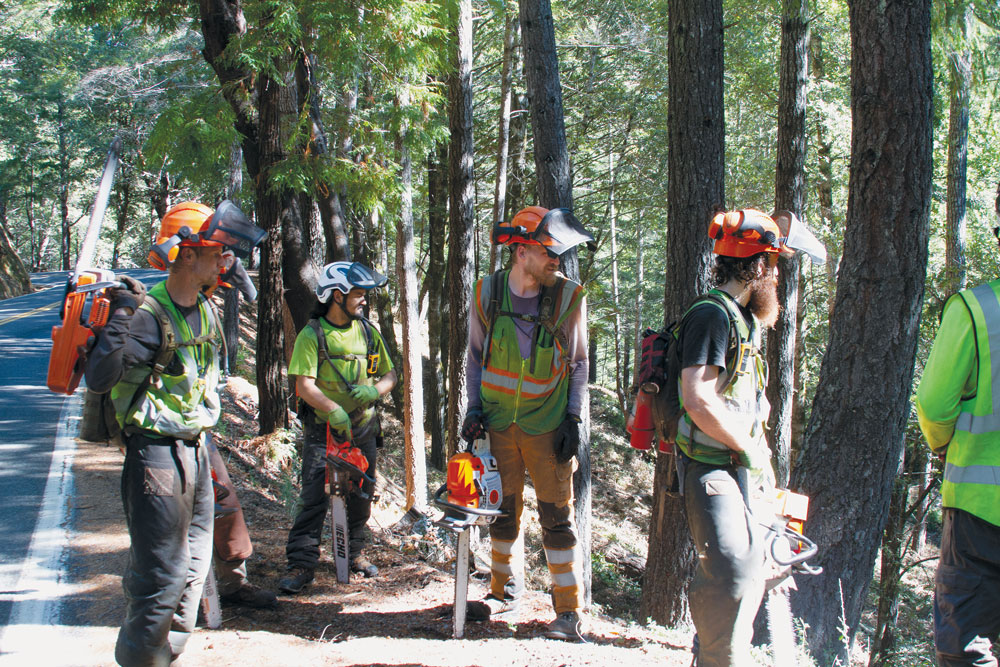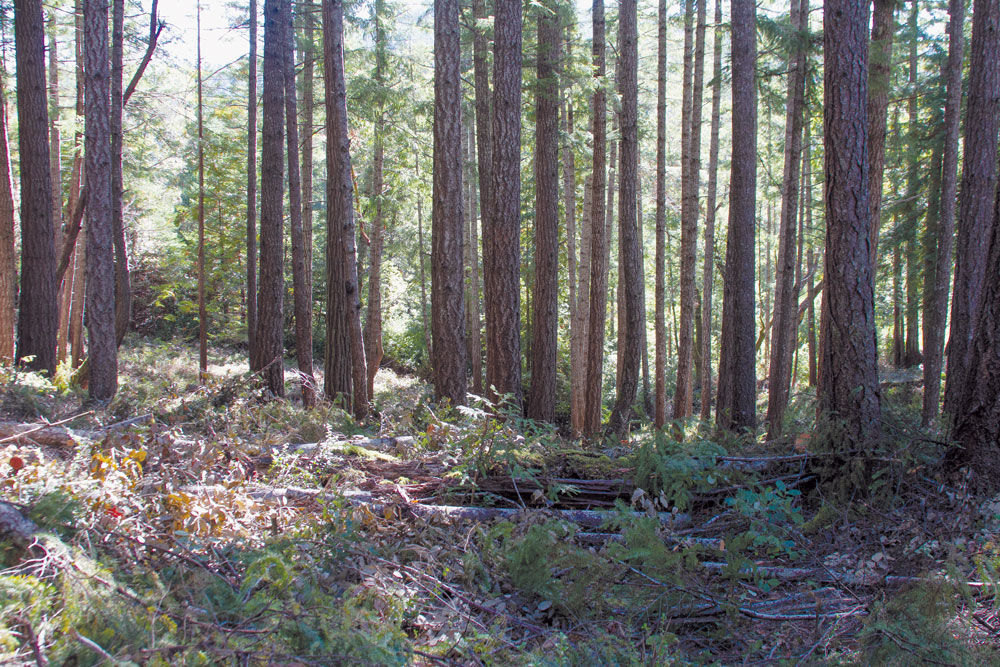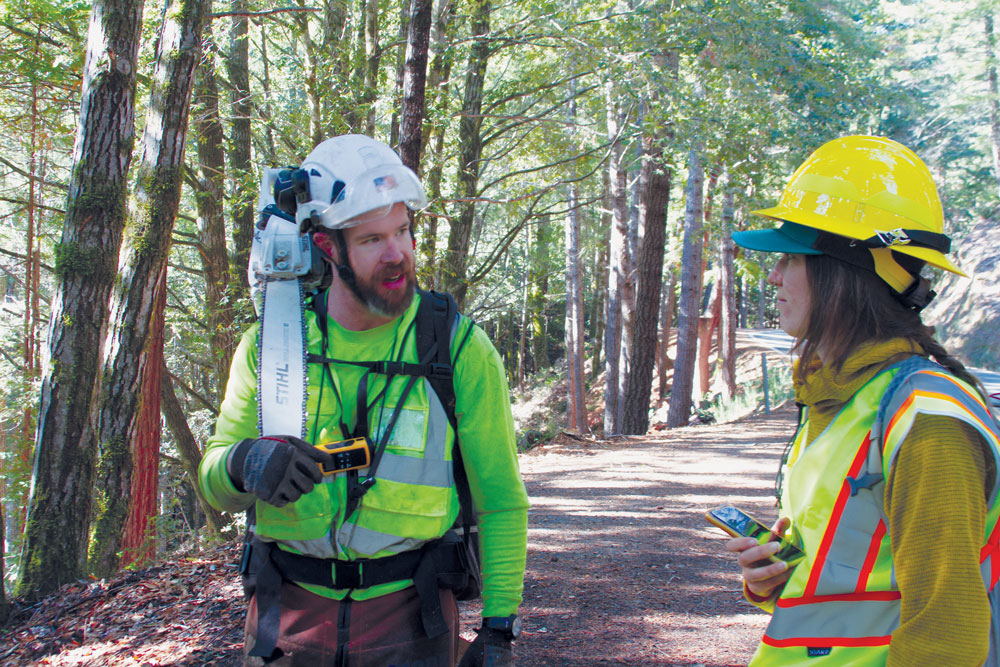Building a Local Workforce for the Restoration Economy

By Cheyenne Clarke and Will Emerson, Northern Mendocino Ecosystem Recovery Alliance
Extraction-based economies boom and bust. Resources run out. Industries collapse. Therefore, extraction is not a viable form of economic growth for the future. So, what is?
Restoration, regeneration, and renewal.
The restoration economy can fill the void left behind by extractive industries. To quote Storm Cunningham, author of The Restoration Economy (2002), this term “refers to economic growth that is based on repurposing, renewing, and reconnecting the natural, built, and socioeconomic environments.” To continue to grow economically we must pivot our focus to the regenerative development of our watersheds, forests, and local economies.
Extractive economies created a tremendous need for regeneration, and there is no shortage of work to be done in healing damaged ecosystems. The landscape of Northern Mendocino and Southern Humboldt is marked by overly dense forest stands and excess fuel loading—conditions that continue to degrade the quality and health of the region’s water and forests. Such conditions increase susceptibility to catastrophic fire, compromise forest carbon sequestration, and threaten the safety of neighboring communities. Remedying unstable conditions requires commitment and coordination for landscape-scale action that targets forest health across public and private ownerships.

Major Forest Health Collaborative Grant Initiates a New Business Model
The $4.9M Northern Mendocino County Forest Health Collaborative grant* awarded to the Mendocino Resource Conservation District (RCD), Bureau of Land Management (BLM), Redwood Forest Foundation, Inc. (RFFI)/Usal Redwood Forest Company (URFC), and Piercy Fire Protection District is a prime example of our regional restoration economy emerging. Below is an excerpt from the Northern Mendocino County Forest Health Collaborative Grant:
This project will treat 1,358 acres on BLM and RFFI properties in Northern Mendocino County. Proposed actions include forest health treatments, shaded fuel break construction, and biomass utilization. Planning includes outreach in Mendocino and Humboldt counties to prepare for the critical expansion of fuel reduction work in Phase II. Targeted benefits include enhanced forest health and carbon storage potential, mitigation of wildfire risk, and support for community safety and local employment.
With a triple bottom line accounting for environmental health, social well-being, and a just economy, this grant requires that the workforce employed to perform the work be local. This grant has been a catalyst for building a forest health team that is locally embedded and available to partner with and bid on grant projects. A new form of work in our region is emerging: it isn’t logging or tree service, but rather a forest health hand crew focused on reducing forest fuels and enhancing forest vitality.
“Like any type of employment, it isn’t there until we have the need. Now we have the need. Now we have the funds,” said Linwood Gill, the Forest Manager for URFC and the 50,000 acres of Usal forest owned by RFFI.
Is the Timing Finally Right for Long-Term Vision?
Timing may be the most valuable element of the equation that is bringing these restoration partnerships and projects to fruition. Compounding ecological imbalances coupled with economic downturns create high demand for land care and jobs.
In November of 2021 when the founding members of the Northern Mendocino Ecosystem Recovery Alliance (NM-ERA) first met, it was due to the Northern Mendocino County Forest Health Collaborative grant and the possibility of regional forest health jobs. Helping to establish a local workforce for restoration projects became a central focus for the newly formed NM-ERA. The group addressed how to build the bridge (or business) to employ local people for regional restoration grant projects.*
The group met online and in person throughout the winter and spring, deliberating how to build local workforce capacity and mulling over the barriers of insurance, licenses, workman’s comp, and potential partnerships. The non-profit served as a sounding board and support system for an alliance that has emerged as a for-profit entity. Vernon Wilson of Wood’s Tree Service, Ben O’Neill with a former fire career, and Willie Grover of Elk Ridge Landscaping Inc partnered together to form a locally embedded fuel abatement workforce under Grover’s contracting license. It is through collaboration that this team has been able to build the workforce bridge and begin work on RFFI’s portion of the Forest Health Project—a shaded fuel break along the major trending ridge of Usal Forest and Highway 1.
“Everyone at RFFI has been really helpful in getting our business going and establishing ourselves as a workforce that is capable,” said Willie Grover.
Redwood Forest Foundation, Inc. started as a bridge between logging and environmentalist communities in order to acquire a large piece of forested property and manage it for the benefit of the local community, thereby keeping profits in the community and providing well-paying jobs while managing the property in a long-term, regenerative manner. We need to have a long-term view, pivoting our perspective from sustaining to regenerating; ensuring the future of the forests and forest communities.
Forest Manager Linwood Gill of URFC/RFFI shares the long-term vision of a regenerative industry that can be carried into the future through multi-aged stand management. The URFC property has four ridges that split the area into four sections, and there are plans for each ridge to become a shaded fuel break in the next seven years. The ridges tend to be dominated by tanoak. By removing brush and trees under a 6-inch diameter, a shaded fuel break is created that promotes habitat and traditional usage of tanoak forests as the ridges become more accessible. After the seven-year shaded fuel break project is complete, it will be time to start maintenance back at the beginning.

The Importance of Partnership and Collaboration
Linwood shared that RFFI had initially applied for this project as a single entity but was denied and given guidance to form regional partnerships for landscape-level restoration projects. Independently planned projects by BLM and RFFI/URFC have been sewn together to create a large-scale forest health and fuels-reduction project (phase I), which will lay the groundwork for an upcoming project phase that will expand landscape-level impact (phase II) into surrounding forested regions. A project of this size is strengthened by the combined investment, experience, and commitment of multiple partners. Partnership is a primary tool for fortitude and resilience in the restoration economy.
Building a regional alliance to work in the woods is challenging, yet it has been supported by forces much bigger than any one individual involved. The emergence of a vital restoration economy requires partnerships, vision, and demand for a new way forward. Grant funding has its trade-offs. NM-ERA founding member Ben O’Neill shares the sentiment that funding is a good thing, but he is also wary of grant projects ending, work being periodically (un)available, the variability of labor budgets, the outsourcing of labor, and the strenuous nature of this work. Still, the demand for work and the need for restoration are glaringly present.
“The workforce is there,” said O’Neill. “I have a list of 20 people who want to come work with us right now. They wanted to come work with us yesterday. So, as soon as we have more projects to deploy that workforce, we will.”
With phase I work on the Red Mountain portion of the project becoming available this winter, the workforce leadership hopes to start another crew. This part of the project will create shaded fuel breaks on over 900 acres of BLM land east of Piercy. There is also potential for a crew to be focused on residential projects and 100-foot home clearances in the future. Overall, the workforce leadership (Grover, O’Neill, and Wilson) hope to establish a business model that is based on long-term growth that can mirror the restoration economy and meet our regional needs, economically and ecologically.
Getting to Work
Starting a new workforce, as crew leader Ben O’Neill shared, has been a significant learning curve with regard to acreage projections. Terrain and density strongly influence how much ground a six-person crew can cover each day. Averaging about 1 acre per day, the current crew has been trained through the process of building a new crew. With his previous experience in CAL FIRE, O’Neill has implemented a safety and training structure that is grooming all members of the current crew (five full-time employees and five part-time alternates) to step into crew leader and assistant crew leader positions on future projects.
According to O’Neill, “Not only was this project amazing as far as what it provided us financially, but it also provided us with the overall training to get this project (building a workforce) off the ground. Regardless of terrain and fuel type, you can see us getting better and better. The crew that we have working right here are the future leaders of our crews. This was an outstanding opportunity to get our baseline figured out—where we are and where we should be—and everybody knows what the standard is now, which trickles down from here on out.”
Each day starts with a safety briefing, and another after lunch. Skills are shared and passed on. Good work habits start from the ground up. It’s one thing to cut a little brush at home. It’s another to do it safely for six hours a day, five days a week in all sorts of conditions, slopes, and fuel types surrounded by other roaring chainsaws and falling branches. It’s vital to find the balance between speed and longevity, to keep tools and bodies functioning well and showing up every day.
Beyond the guys and gals with chainsaws, there will be opportunities for other roles as the work expands: saw technicians, mechanics, quality control specialists, workforce trainers, safety officers, surveyors, forest technicians, foresters, biologists, fire bosses, bookkeepers, grant writers, donut makers, etc. It’s important to build paths upwards so people can stay in the field and share their hard-won skills long after their bodies can no longer take the daily grind of running a saw.
This is Economic Development even if it doesn’t look like it. There are so few good jobs in our region, and they have always been involved in selling off our resources cheaply—a repeated “boom and bust” economy. A lot of people hoped that the cannabis industry would change that, but it too was just another gold rush boom to be followed by a hard bust. So now it’s time to rebuild our economy based on taking care of the land around us and restoring the natural abundance that the native people cultivated here. Yes, it will take outside money like grants to get this going. Yes, there is a lot to learn and mistakes will be made. Yes, there are many challenges ahead, but stop and listen for a moment: that’s the sound of the forest growing every day.
Our region needs viable futures, meaningful jobs, and widespread restoration. The Northern Mendocino Ecosystem Recovery Alliance aims to continue to build capacity as a regional organization to support the development of the restoration economy through grant funding, partnerships, project planning, administration, and training. The NM-ERA plans to help with training people and finding work for them. The first training opportunity will be at Tan Oak Park later this fall. Stay tuned for details.
For more information visit www.nm-era.org and join the mailing list. The organization is recruiting community members who support the vision and have the skills, energy, and experience to add to our committees. To join the organization and the movement, please reach out to [email protected].
